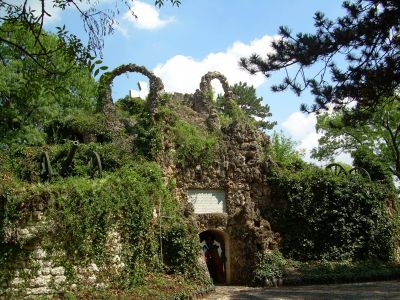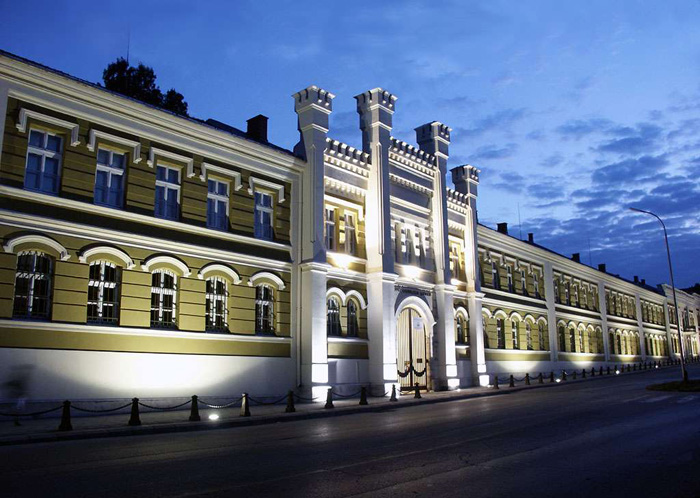The old bridge on the river Vit near Pleven
The old bridge on the Vit river is an important economic and commercial infrastructure outside the city, related to the history of Pleven from the time of the Russo-Turkish war 1877-1878. Five months of fighting continued, three bloody storms marked the development of the Pleven epic, and its end was decided in the Vit river valley around the Usta Gencho bridge. After a third unsuccessful assault on the city on August 30/September 11, 1877, the Russian military command decided on a siege. The blockade ring is about 50 km long and is divided into 6 sections. Through the sixth section, entrusted to the Grenadier Corps, passes the main supply and communication artery of Osman Pasha's army - the road to Sofia with the stone bridge over the river. After battles near the villages of Gorni Dabnik and Telish in October, the Russian Guard completely broke this strategic link. There remains a decisive battle for the city, which will take place in early December in the Vit river valley.
On November 28/December 10, 1877, the Turkish army made a desperate attempt to break through the blockade ring and leave the city in the direction of Sofia. Osman Pasha's advance was rapid and successful, they broke through both lines of the Russian defense. But the situation is rapidly changing. The units of Osman Pasha, who was wounded in the leg, were halted and driven back to the river by the grenadiers. The finale of the five-month battle for Pleven took place around the bridge. The bridge is mentioned in all documents related to the fall of the city and is present in all artistic depictions of the fateful battle. On the bridge pass the parliamentarians, in front of him, the commander of the Grenadier Corps, General Ganecki, is waiting for the announcement of a complete and unconditional surrender, confirmed personally by Osman Pasha.
The bridge at the river Vit has been out of service for a long time. It has been declared a cultural monument of national importance. In 2013, with funds from a European program, restoration and restoration of the bridge in its original appearance, created by the master Gencho Kanev, was carried out.
Interactive map


"St. George the Victorious"
























The imposing building - Panorama "The Epic of Pleven 1877" was built in connection with the 100th anniversary of the battles at Pleven during the Russian-Turkish war 1877-1878 and the liberation of the city on 10.12.1877.
See more

"St. George the Victorious"
To perpetuate the memory of the heroes of the Pleven epic, in 1902, the "Tsar Liberator Alexander II" committee, under the chairmanship of the prominent revivalist and writer Stoyan Zaimov, decided to erect a chapel-mausoleum in Pleven.

The museum complex House-Museum "The Liberation of Pleven 1877" and the park attached to it were built together with its adjacent artistic and decorative fence in 1907, in honor of the 30th anniversary of the Liberation of Pleven -1877.

In 1898, at a municipal session, the condition of the Russian monuments from the Liberation War was considered, measures were proposed for their restoration and for preserving the bones of the Russian and Romanian soldiers who died in the battles for Pleven. At the same time, the Association of Bulgarian fighters and militiamen established a special committee, which was entrusted with the maintenance of the existing monuments from the war and the construction of new ones, as a sign of gratitude to the Russian people and Emperor Alexander II. The initiative is supported by the state institutions and the entire Bulgarian people. To the south of the city, on the former battlefield, where several Russian monuments are already standing, land has been allocated for the construction of a memorial park named after Gen. M. D. Skobelev.

The Romanian mausoleum near the village of Grivica was opened in 1902 on the occasion of the 25th anniversary of the Russo-Turkish War of 1877-1878 and the participation of the Romanian army in the battles of Grivica and Pleven in 1877.

The house of Ivan Stoykov-Troyanchanina was built in the period 1862-1865. In 1877, the Russian emperor, the commander-in-chief of the Danube Russian army, the Romanian prince, prominent Russian military leaders resided there. From October 26 to December 10, the Russian Headquarters was quartered here.

Varban Iliev's house was built after the war, in close proximity to the building where the Romanian General Headquarters was housed and where Prince Karol I lived during the battles for Pleven.

The old bridge on the Vit river is an important economic and commercial infrastructure outside the city, related to the history of Pleven from the time of the Russo-Turkish war 1877-1878. Five months of fighting continued, three bloody storms marked the development of the Pleven epic, and its end was decided in the Vit river valley around the Usta Gencho bridge.

The history of the Pleven area is a thousand years old. Discovered paleontological findings testify to life on these lands from 70 million years ago. The rich historical past and the preserved ruins of ancient fortresses and buildings early on provoked the interest of Pleven intellectuals-enthusiasts in their study. In 1903, an Archaeological Society was founded, which set itself the goal of creating a museum.

The late antique and medieval fortress Dianenzium/Dianensium Storgozia/Pleven is located in Kaylaka Park 2.7 km south of the center of the city of Pleven, on a high flat plateau, on the left bank of the Tuchenitsa River, which is naturally protected by the steep banks of the river. The place keeps traces of inhabitants from the bronze age.

The Church "Saint Nicholas the Wonderworker" is a medieval Bulgarian Orthodox church in Pleven, declared a cultural monument. It is located in the center of the city, in the immediate vicinity of the Drama Theater "Ivan Radoev".

Academician Svetlin Rusev is a world-renowned artist whose paintings delight connoisseurs from all continents. He is one of the biggest art collectors in Bulgaria and one of the most generous donors.
In 1984, Academician Svetlin Rusev presented to his hometown Pleven 322 works of art - painting and sculpture - from his personal collection.

The building used by the "Ivan Radoev" Drama and Puppet Theater was built at the end of the 19th century, as a building of the first community center in Pleven. On October 1, 1869, Nestor Markov, a well-known teacher from Pleven at that time, gathered a hundred awake and liberal citizens who donated their own funds as founders and facilitators of the first community center in the city of Pleven.

The monument of the 4th infantry regiment of Pleven is one of the most impressive military monuments in Bulgaria, erected in memory of 140 officers, non-commissioned officers and soldiers who died in the Serbo-Bulgarian war of 1885. It was built with the funds of the regiment and the relatives of the dead. It is the work of the sculptor Zheko Spiridonov - one of the founders of modern Bulgarian sculpture.
The ruins of the medieval village of Turnu are located in the southern part of Turnu Magurele at a distance of 4 km from the city and 1 km from the confluence of the Danube and Olt rivers. According to historians, the first reviews of the fortress on the left bank of the Danube appear from the second century AD, and in ancient documents the fortress is mentioned as a "strong fortification".

The bridge over the Sai River is located in a section of an old road route closed to traffic, located south of and parallel to the DN 54 road, which connects the towns of Turnu Măgurele and Islaz. This section of the old route starts as a westward continuation of Strada Popa Săpcă Street and merges into DN 54 eastward, to the banks of the Olt River.
The elegant steel-framed bridge was built in 1917, during the German occupation. It was a strategic target for conducting military operations. The bridge is depicted on postcards as an important tourist site for the region.

The water tower, Turnu Măgurele is located on 1st of December Street No. 8. It was built in 1915 to supply the city with water. It has been declared a historical monument. The water tower rises to a height of 27 meters and is the tallest structure in Drobeta. It was built in a historical style, at the highest elevation in the city, 104 meters above sea level, to ensure the city's water supply. During the First World War, the tower was used by the German army for observation. In 2010, the tower was included in a modernization and restoration project. The design proposal is for the building to house a tourist information center, an exhibition space and an art gallery, a museum "History of the water supply of Drobeta Turnu Severin municipality", an exhibition with photographs and sculptures, a literary cafe and a viewing platform.

The Cathedral "St. Haralampii" in Turnu Magurele is considered the most representative monument of church construction from the beginning of the 20th century in Teleorman County.

The official establishment of the town of Turnu, today's Turnu Magurele (named so as to distinguish it from Drobeta Turnu Severin and Turnu Roshu) was decided on February 27, 1836 during the reign of ruler Alexandru Ghika.

The children's club is located opposite the railway station in the northern part of the city. Until 1945, the building was used by the Regional Chamber of Agriculture and as a boarding school for the Agro-Industrial High School. The architecture of the building is in Byzantine style with rotundas, columns and inlays.

The Tribunal - the Palace of Justice was built in 1893 according to the French model. The building is used today by the Teleorman District Court. The building has impressive proportions, harmony and functionality, characteristic of Italian master builders. In 1923, a new wing was built, and in 1997, the building was completely renovated.

Plamuk Cinema is a chic building, opened in 1928, in Romanian architectural style. It is located in the Central City Park and resembles a city theater, with a capacity of 375 seats.

The monument was erected in 1985 by a group of architects from Bucharest. It is located on the main avenue at the entrance to the central park of Turnu Magurele.

The statue of Dorobantsi was made by the Italian sculptor Raffaello Romanelli in 1907, in honor of the feat of the infantrymen in the War of Independence in 1877-1878. The statue was made in memory of Corporal Nikola Tudorika - popularly known as "Tudorika Dorobantu", who fell heroically in the battles of this war. The statue depicts an armored warrior - a dorobant, with his right hand raised forward and a hat, the keel a little backwards. On the pedestal of the monument there are bas-reliefs depicting battle scenes and an eagle with outstretched wings grasping with its claws a "letter" with the names of the heroes. Two Turkish cannons, captured by the Romanian soldiers in Pleven, are displayed on both sides of the monument.

Mircea cel Butrun is a national hero who rebuilt and strengthened the Turnu fortress as a defense against the Ottoman invasion. The monument is made of bronze and erected in 1968 by the sculptor Oscar Khan from Bucharest.

The bust is the work of the sculptor Gheorghe Iliescu-Culineschi, in honor of General David Praporgescu, who fell on the front during the First World War.
Geocoding Error Occurred.
Tried to Geocode:
Error Type:
Please be sure to follow the tutorial on how to setup the Google APIs required for the Advanced Google Map Widget.
Google Map API Key Tutorial
